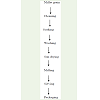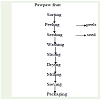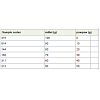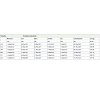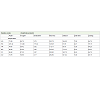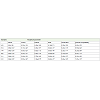Research Article
Evaluation of Proximate, Pasting and Sensory Properties of Complementary Food from Millet and Firm Ripe Pawpaw Flour Blends
Egwujeh*, Simeon Iko-Ojo Dignity, Adeyemi, Stephen Ayodele, Egbunu, Gabriel Friday
Department of Food, Nutrition and Home Sciences, Faculty of Agriculture, Kogi State University, Anyigba, Nigeria
Corresponding author: Egwujeh, Simeon Iko-Ojo Dignity, Department of Food, Nutrition and Home Sciences, Faculty ofAgriculture, Kogi State University, Anyigba, Nigeria, Phone number: +23408037444259; E-mail: egwujeh.sid@ksu.edu.ng oridesnig@gmail.com
Citation: Egwujeh, Iko-Ojo Dignity S, Adeyemi, Ayodele S, Egbunu, et al. Evaluation of Proximate, Pasting and Sensory Properties of Complementary Food from Millet and Firm Ripe Pawpaw Flour Blends. Indian J Nutri. 2016;3(1): 128.
Copyright © 2016 Egwujeh*, Simeon Iko-Ojo Dignity, et al. This is an open access article distributed under the Creative Commons Attribution License, which permits unrestricted use, distribution, and reproduction in any medium, provided the original work is properly cited.
Indian Journal of Nutrition | ISSN: 2395-2326 | Volume: 3, Issue: 1
Submission: 17/06/2016; Accepted: 29/06/2016; Published: 06/07/2016
Abstract
Complementary food was formulated from millet and firm ripe pawpaw flour blends. The formulations were coded 415, 514, 144, 652, 311 and 212 while 415served as control. The proximate compositions, sensory and pasting properties of the formulations were evaluated using standard methods. The result of proximate composition showed significant (p≤0.05) decrease in moisture content, increase in ash, fibre and carbohydrate content acceptable level of fat as substitution with firm ripe pawpaw flour increased. There was, however, an insignificant effect of pawpaw on the protein content of the food. Pasting properties showed variations in the pasting viscosity of the blends and little differences in pasting temperature. There was slight reduction in pasting temperature of thesamples, an indication of shorter cooking time. Sensory evaluation showed no significant (p≤0.05) difference between samples 415, 514, 144, 652 and 311 for colour, texture and taste. These were significantly different from sample 212 for the attributes of colour, texture, taste, and mouth feel. Although samples 415, 652 and 212 compared favorably with the control, sample 212 containing 50/50 millet/pawpaw flour was most accepted. All the samples showed no difference in aroma. The study showed that papaw and millet flours could be used in the production of complementary food with high energy value, mineral and quality protein that could play a key role in reducing energy mal-nutrition.
Keywords: Complementary food; Sensory properties; Pasting properties; millet; Pawpaw; Flour
Introduction
Complementary food is any food other than breast milk givenbetween the time the diet consist exclusively of mother’s milk andthe time when it is mostly made of family foods. Complementaryfeeding is giving infants foods or fluids other than breast milk. It canbe specially prepared for the infants or can be the same food availablefor the family members, modified in other to meet the eating skillsand needs of the infants [1]. Most complementary foods are madeof cereals and legumes individually or in combinations as individualmight not meet the nutritional needs of the infants. In view of this,there is need to have maximum utilization of commonly neglectedcereals such as millet (Pennisetum glaucum) of high nutritionalcontent and other plants with high vitamin and mineral content such as Pawpaw (Carica papaya) in the formulation of complementaryfoods.
Millets are a group of variable small-seed grasses widely grownaround the world as cereal grains and are the major source of caloriesand proteins in developing country like Nigeria. They are rich in Bvitamins, especially niacin, B12, B6 and folic acid [2]. The most widelygrown is pearl millet which is an important crop in semi-arid andimpoverished less fertile agricultural region of Africa and south EastAsia [3]. Nutritionally millet is comparable and even superior tomajor cereals with respect to energy value, proteins, fat and minerals.It makes an important contribution to human diet due to high levelsof calcium, iron, zinc, lipids and high quality proteins. Besides it isalso a rich source of dietary fibre and micronutrient. The whole grain is used in soups, stews or as cooked cereals. Millet can also be poppedroasted or sprouted [4].
Papaya (Carica papaya) is an important fruit crop throughoutthe tropical and sub-tropical Africa. It is favored by people in thetropics as breakfast and as ingredient in the jellies, preserves orcooked in various ways. It is rich in vitamins and minerals; the fruithas pronounced bactericidal effects [5]. Preservation of pawpaw fruitposes a big problem particularly in rural areas where there are nosteady electricity supply and inadequate storage facilities like coldstore room or refrigerators, as a result farmers are compelled to eitherlet them rot away or dispose them at a giveaway prices during glutseason. Dried pawpaw fruit has the potential of been incorporatedinto other traditional foods in Nigeria. Given its remarkablenutritional potential, there is need for utilizing it thereby reducingits wastage. Nowadays, papaya is used in baked products for weightconscious persons and the use of composite flour is advantageous insupplying carbohydrates for human nutrition and encourages betteruse of local or domestic agricultural products as flours [6]. Egwujeh,et al. [7] had earlier reported acceptable biscuits from blends of wheatand pawpaw flours.
Pasting properties of food can be correlated to the cooking qualityand textural of the food hence a good index of textural quality in moststarchy foods. The pasting temperature gives an indication of theminimum temperature to cook a food.
Food insecurity and under nutrition are more than lack offood energy but are mostly caused by micronutrient deficiency [8].Overcoming under nutrition by the use of local resources will protectand promote the utilization of such resources against importationand as well educate or train local populace on local materials forfood production and nutrition orientation. Many African mothers,especially those from low income class feed their infants withcomplementary foods that are inadequate in energy value poorswallow ability and deficient in micronutrient (especially Iron, zinc,calcium, vitamin A, vitamins C and B).
This study is therefore significant in formulating food fromcommonly and available crops that are affordable, easily preparedby any African woman locally from family foods that could meetthe characteristic standard of complementary food for infants.Information on the effects of pawpaw supplementation oncomplementary food from millet is lacking. The objective of thisstudy therefore was to produce complementary food from milletand firm ripe pawpaw flour blends and to evaluate the proximatecompositions, pasting and sensory properties of the complementaryfood.
Materials and Methods
Source of material
Millet (Pennisetum glaucum) was purchased from a main marketof Anyigba town, Kogi State Nigeria while pawpaw (Carica papaya)fruit was obtained from the garden of Kogi State University, Anyigba.Equipment including knife, trays, buckets, hammer mill, weighingbalance, sealer, fan driven hot air oven and sieves were provided byfrom laboratory of the Department of Food, Nutrition and Home Science, Kogi State University, Anyigba Nigeria.
Preparation of millet flour
The millet grains were cleaned of dirt, stones and other extraneousmaterial, and soaked in clean water for 8hours. The soaked grainswere washed, sundried, milled with locally fabricated hammer mill,sieved using a 40 mesh size sieve and packed in a polyethylene bag.The flow chart for the production of millet flour is shown in [Figure 1].
Preparation of firm ripe pawpaw flour
Firm ripe pawpaw fruit were plucked, cleaned, peeled manuallyand the seeds removed. Thereafter the mesocarp was washed andsliced into thin slices (about 1mm). The sliced mesocarp was driedusing fan driven hot air oven to fairly constant weight. The driedsample was milled using hammer mill, sieved using a 40 mesh sieveand packaged in polyethylene bag as shown in [Figure 2].
Formulation of complementary food
The complementary food was formulated using millet and pawpaw flour blends as shown in the Table 1 below.
Chemical analysis
The moisture, crude protein, ash, crude fibre and fat contentof the complementary food samples were determined followingthe procedures described by AOAC [9], while carbohydrateswas calculated by difference according to Onwuka [10]. Energywas calculated using Atwater factors (9 X fat + 4 X protein + 4 Xcarbohydrates) as described by Yusufu [11].
Determination of pasting properties
In this study, the pasting properties of the formulatedcomplementary food were determined with Rapid Visco Analyser(RVA) (model RVA 3D± New port scientific Australia) [12]. Sampleof fine powder was milled, and the moisture content was determined.Three gram (3g) of flour (on 100% dry matter basis) was weighed intoa canister, fitted with paddle and the canister was inserted into the instrument, the measurement cycle was initiated by depressing themotor tower of the instrument when the computer says ‘press downthe tower’. Finally the canister was removed on completion of test.
Sensory evaluation
The formulated complementary food was evaluated on theattributes of colour, aroma, texture, taste, mouth feel and generalacceptability using a 9 point Hedonic scale (9-like extremely,1-dislike extremely). The panellist drawn from staff and students(nursing mothers) in Kogi State University, Anyigba were servedwith the complementary food samples in a randomised order. Thescores obtained were subjected to statistical analysis using multiplecomparisons Test and the means was evaluated using one wayAnalysis of variance (ANOVA) and difference established usingT-test [13].
Results and discussion
Proximate composition
The Proximate compositions of the complementary food arepresented in Table 2. Differences (p ≤ 0.05) existed between thecontrol (sample 415) and those containing pawpaw flour in termsof moisture, ash, fibre, protein and fat. There was a general increasein carbohydrates, ash and fibre with increasing levels of pawpawflour. On the other hand, protein content of the food decreased withincreasing addition of pawpaw flour. The low moisture content (13-16.6%) of formulations was an indication that the products wouldhave better storage stability than the control. The moisture content ofa food predicts its shelf life as it may encourage microbial activities,enzymatic and none enzymatic reactions leading to spoilage [14]. Theash content gives an indication of the mineral composition preservedin foods [15,16]. The ash contents of the formulations range from0.55-1.00%. Higher ash content in the formulation was an indicationof higher mineral contents than the control.
Fibre is an indigestible component of plant material that helps inimproving roughage and as well contributes to a healthy conditionof the intestine [17]. Fibre helps in the maintenance of human healthand has been known to reduce cholesterol in the body [18]. The fibrecontent ranges from 0.88-1.30% showing higher values than thecontrol 0.80%. It has been reported that infant cereal should be 0.3-2.5%. Values obtained in this study are within this range indicatingthat the formulations could be adopted in infant feeding.
Although the protein content of the formulated complementaryfoods were lower than the 13-14g RDA recommended for infants upto one year, they meet 40-50% (1.38 to3.15 g/100g) reported by Anigoet al. [19]. The low fat (5.4-7.8%) content of the samples could be anadvantage for prevention of obesity and as well support the stabilityof the food during storage. The carbohydrate contributes the bulk ofenergy of the formulations. High carbohydrate contents of the blendsmake them ideal for babies since they require energy for their growth.The energy values of the complementary foods ranged from 346.6kcal in the control (sample 415) to 367.08kcal in sample 212. This showedthat the formulations might supply enough energy for the infants togrow.
Pasting properties
The pasting properties of the complementary formations areshown in Table 3. The Peak viscosity ranged from 44.46-231.42 RVUreducing as substitution with pawpaw increased. The difference in thepeak viscosity may be attributed to different rates of water absorptionand swelling of starch granules of the flours during heating whichwould have been influenced by the increase in sugar content of thefood. High sucrose ties up water molecules making them unavailablefor starch thereby inhibiting normal swelling of starch. Breakdownviscosity is regarded as a measure of the degree of disintegration ofstarch granules or paste stability during heating. The implicationof this observation is that sample 311 flour blend with the lowestbreakdown value (2.67 RVU) was more resistant to heat and shearforce during heating and that there was less starch granule rupturewhich could therefore guarantee a more stable cooked paste [20,21].Chinma et al. [22] had equally reported similar observations for fullfat soybean and cowpea starches.
Final and setback viscosities reduced in most cases. The lowfinal viscosity observed in the samples indicated low tendency of thesamples to retrograde [23]. Since setback viscosity is an indicationof the stability of cooked paste against retrogradation it can be used to predict the storage life of a product prepared from the flours [24].The low setback values observed in the samples indicated low rates ofstarch retrogradation and syneresis tendencies hence the formulatedproducts will have long storage life. Higher values of setback hadearlier been reported for full fat soybean and cowpea starches [22].The pasting temperature is the temperature when viscosity first byat least 2RVU over a 20s period [25]. The similarities in pastingtemperatures of the blends indicate the substitution of pawpaw atthese levels had little or no effect on initial pasting temperature of the flour blends [24].
Sensory analysis
The sensory attributes of the complementary formulations areshown in Table 4. Statistical analysis showed that there were nosignificant (p ≤ 0.05) difference among the samples in all the attributesevaluated except over all acceptability. Panellists showed preferencefor samples containing 10%, 20% and 30% pawpaw flour which werenot significantly different(p ≤ 0.05) from the control. However, thesewere significantly different from those containing 15% and 25%pawpaw flours respectively.
Conclusion
The study had showed that complementary food of acceptablequality and energy could be prepared from millet and firm ripepawpaw flour blends. Although the incorporation of pawpaw resultedin reduced protein content of the samples, other nutrients as wellas content energy, pasting properties and sensory attributes weresignificantly improved upon. The technology involved in this workwere simple, millet and pawpaw are readily available in Nigeria atan affordable price hence a good choice in regions were the availablecomplementary foods are expensive.
Acknowledgement
With kind regards the authors acknowledge the department ofFood, Nutrition and Home Sciences, Kogi State University, Anyigbafor making the laboratory available for this work to be carried out.We are grateful.
References
- WHO (1998) Complementary feeding of infants and young children: report of a technical consultation: World Health Organization Geneva.
- Olaitan NI, Eke MO, Uja EM (2014) Quality evaluation of complementary food formulation from Moringa Oleifera leaf powdered and pearl millet (Pennisetum glaucum) flour. Int J Engineering and sciences 3: 1805-2319.
- Obilana AB, Taylor JRN (2002) Status and development needs of processing and utilization technologies for sorghum and millets: experiences from southern and implications for West and Central Africa (WCA). Presented to the CFC expert meeting to identify and prioritize research and development needs and activities for WCA. Bamako, Mali. 23-36.
- Malik M, Singh U, Dahiya (2002) Nutrient composition of pearl millet as influenced by genotypes cooking methods. J Food Sci Technol 39: 463-468.
- Barry T (2000) “Papaya health†benefit of papaya in medicine cancer and other diseases 20-26.
- Anam AA, Aumir S, Sairat P (2014) Rheological properties of papaya enriched wheat flour for baked products. Pakistan J Food sci 24: 126-131.
- Egwujeh SID, Amanabo LO, Yusufu PA (2009) Production of biscuit from wheat and pawpaw flour bend. Proc. of 33th Annual Conference/ AGM of NIFST 12-16 October. Edited by Prof. Iro Nkama: 51-52.
- Krawinkel BM (2012) Overcoming undernutrition with local resources in Africa, Asia and Latin America. J Sci Agric 92: 2757- 2759.
- AOAC (2000) Official methods of analysis Association of official Chemists 17th edition.
- Onwuka GI (2005) Food Analysis and Instrumentation. Theory and Practice Napbthali Prints, No.6 Adeniyi Jones Close, Surulere, Lagos, Nigeria.
- Yusufu PA, Netala J, Opega JL (2016) Chemical, sensory and microbiological properties of cookies produced from maize, african yam bean and plantain composite flour. Indian J Nutri 3: 01-05.
- Morthy RS (1994) Interpreting of result with rapid visco analyzer (RVA) manual section 5, New porth Scientific, Australia 25-28.
- Iwe MO (2004) Hand Book of Sensory Methods and Analysis. Rejoint Communication Services Ltd. 65, Adelabu St, Uwani-Enugu.
- Egwujeh SID, Ariahu CC (2014) Effects of pretreatment on moisture sorption characteristics of velvet bean (Mucuna flagelipse) flours. Journal of Applied Agricultural Research.
- Omotoso OT (2005) Nutritional quality, functional properties and anti-nutrient composition of the larva of crinaforda (Westwood) (Lepidoptera: Saturniidae). J Zhejiang Univ Sci B 7: 51-55.
- Nnamani CV, Oselebe HO, Agbatutu A (2009) Assessment of nutritional values of some underutilize indigenous leafy vegetable of Eboyi State Nigeria. Afr J Biotechnol 8: 2321-2324.
- Potter NN, Hotchkiss JT (2004) Food Sciences. 5th Edition, CBS Publishers and Distributors, New Delhi. 55-583.
- Bello MO, Falade OS, Adewusi SR, Olawore NO (2008) Studies on the chemical compositions and anti-nutrient of some lesser known Nigeria fruits. African Journal of Biotechnology 7: 3972-3979.
- Anigo KM, Ameh DA, Ibrahim S, Danbauchi SS (2009) Nutrient composition of commonly used Complementary foods in North Western Nigeria. Afr J Biotech 8: 4211-4216.
- Farhat IA, Oguntona T, Neale JR (1999) Characterization of Starches from West African Yams. Journal of Science of Food and Agriculture 79: 2105-2112.
- Ragaee S, Abdel-Aal EM (2006) Pasting properties of starch and protein in selected cereals and quality of their food products. Food Chem 95: 9-18.
- Chinma CE, Abuh JO, James S, Iheanacho M (2012) Chemical, functional and pasting properties of defatted starches from cow pea and soy bean and application in stiff porridge preparation. Nigerian Food J 30: 80-88.
- Moorthy SN (1994) Tuber crop starches. Technical bulletin series: 18: 5-39.
- Zaidul IS, Yamauchi H, Takiyawa S, Matsuura-Endo C, Suzuki T, et al. (2007) Correlation between the Compositional and Pasting Properties of Various Potato Starches. Food Chem 105: 164-172.
- Bakare HA, Osundahunsi OF, Adegunwa MO (2012) Composition and pasting properties of breadfruit (artocarpus communis Forst) from south west states of Nigeria Nigerian. Food J 30: 11 -17.

